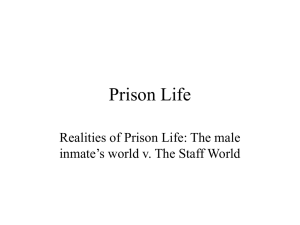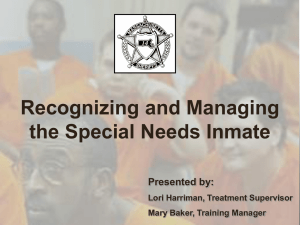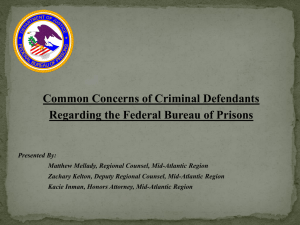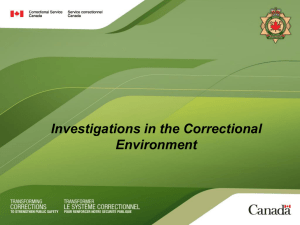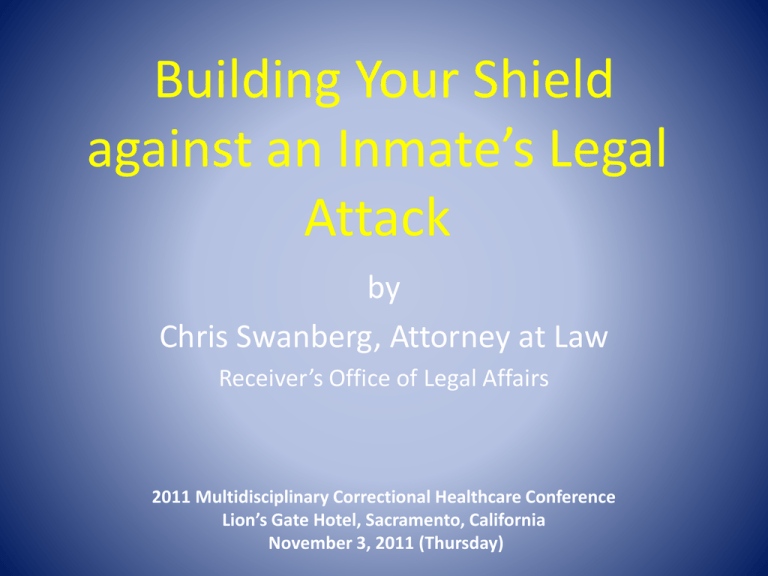
Building Your Shield
against an Inmate’s Legal
Attack
by
Chris Swanberg, Attorney at Law
Receiver’s Office of Legal Affairs
2011 Multidisciplinary Correctional Healthcare Conference
Lion’s Gate Hotel, Sacramento, California
November 3, 2011 (Thursday)
This lecture and all opinions expressed by the
lecturer are his/her opinions alone and do not
represent the opinions of nor endorsement of
the CCHCS, CDCR, California State Government
or any other organizations.
Any republication, retransmission, and/or
reproduction of all or part of any materials
presented herein is expressly prohibited, unless
the copyright owner of the material has
expressly granted its prior written consent to so
republish, retransmit, or reproduce the
material. All other rights are reserved.
Medical-legal issues in
the free world
(and prison)
Physicians and nurses working in prisons are
no different from their counterparts in the free
world in regards to concerns about medical
malpractice, professional licensing boards and
peer review.
HAVE YOU EVER BEEN SUED?
A recent study concluded that statistically every physician will be sued at
least once during their career.
MORAL: You WILL be sued, so plan for it.
Swanberg’s note: If you are a CME or a CP&S your chances of being a named
defendant in an inmate lawsuit go up exponentially. (Ex. The CME at CMF has been
sued, at last count, 135 times.)
LEGAL (COURT) ACTIONS BY INMATE/PATIENTS
There are three main types of legal actions filed by inmate patients where a
physician may be named as a defendant:
1. A Habeas Petition
2. A Federal constitutional claim (e.g. civil rights
violation, deliberate indifference, or other constitutionally
based claim.
3. A malpractice claim
In addition, inmates are more frequently filing claims with licensing boards, such as
the California Medical Board as well.
The Petition for Habeas Corpus
• A relatively common
legal action brought by
the inmate challenging a
condition of
confinement. In medical
cases usually claiming
that the CDCR medical
staff is deliberately
indifferent to the
inmate’s healthcare
needs.
• Sometimes individual
physicians are named in
the accusation or text of
the petition. However,
physicians cannot be
held personally liable in
any way through this
claim.
The Petition for Habeas Corpus
• The only remedy
available to the
inmate/patient
(Petitioner) for this
kind of claim is a
court order to enact
certain types of care
requested. No
monetary damages.
• It is important to note
that these cases are
NOT medical
malpractice cases so
they should not be
reported as such in
answering questions
to insurance carriers or
medical staff’s
applications.
The Petition for Habeas Corpus
• Physicians practicing
according to
utilization
management and
quality assurance
guidelines can
describe their
decisions to the
inmate as being
consistent with best
practices.
• An appropriate
explanation for a
denial of MRI, for
example, is to educate
the inmate as to the
best practices that
focus on symptom
management and
functional status and
do not recommend
MRI.
Deliberate Indifference
Usually an underlying claim in a Habeas case or Federal Court lawsuit
Deliberate indifference in the medical context
occurs when an inmate’s needs are ignored
and no decision making process is brought to
bear to reach a decision on appropriate care.
Deliberate indifference cannot exist where a medical decision was made,
even if that decision was wrong. The error may constitute malpractice but
cannot constitute deliberate indifference.
SHIELD POINTER: Do you carefully document your decisions in the chart?
Your note should address each presenting complaint – some diagnosis is
better than none.
EXAMPLE
Inmate Phil Smith claims he has been denied back surgery by Dr.
Ernest and is not receiving adequate pain medications to manage his
pain. He sues alleging “deliberate indifference”. A reasoned decision to
avoid back surgery in favor of more conservative care will not support a
claim for “deliberate indifference” and obviously controlling the amount
of opiates cannot be a “deliberately indifferent act.” Dr. Ernest may
reduce the likelihood of suit by sending his more difficult cases to
committee for their determination.
Let us consider a the possibility of a complaint filed with the
medical board against Dr. Ernest by family of a deceased Phil Smith a
few months after he died from post operative complications of spinal
surgery deemed unnecessary by experts hired by the Smith family.
Your thoughts?
SHIELD POINTER: Following UM guidelines can help avoid referrals later
deemed “unnecessary”.
Civil Rights Actions
• charges against any
• If the Plaintiff can
person acting “under
prove the denial of
color of State law”
constitutional rights,
claiming a violation
awards can be
of United States
substantial including
Code title 42 section
payment of attorney
1983 for deprivation
fees, monetary
of the rights afforded
damages and
under the
punitive damages.
Constitution.
Civil Rights Actions
Unless physicians
actions are actually
beyond the pale of
reason and decency, it
is difficult to a point
approaching virtual
impossibly for an
inmate to make a case
imposing personal
liability upon a
physician based on
civil rights violations.
• Your denial of a
controversial therapy, or
any denial based upon your
best judgment will never be
a successful ground for a
civil rights claim.
ON THE OTHER HAND:
Providing different treatment
for the same condition to a
Hispanic inmate as compared
to a White inmate can serve
as a basis for a successful civil
rights claim.
EXAMPLE
Inmate Pearl Jones complains that she underwent a
hysterectomy under your orders that leaves her (obviously)
permanently infertile. She accuses you of maliciously
sterilizing her without any medical necessity, treating her
differently from others in similar circumstances on account of
her race.
You requested/authorized the hysterectomy after a
community gynecologist recommended the procedure to treat
dysfunctional uterine bleeding.
How can you reduce risk of claims against you?
SHIELD POINTER: Well documented informed consent for any
procedure is worth it’s weight in gold in litigation cases.
Medical Malpractice
• To prevail and win a
monetary award (which is
• Claims usually filed in
the purpose of the suit)
the state superior
the patient filing the
court by the patient or
action (Plaintiff) must
his/her survivor(s)
prove to a judge or 9 out
who allege(s) damage
of 12 jurors, by the
by a healthcare
preponderance of
professional or
evidence, that the health
healthcare
care professional
organization’s error.
(Defendant) failed to
meet the standard of care
and that this failure
caused harm.
Medical Malpractice
• It is important to
• Of the lawsuits filed naming
appreciate the
CDCR physicians as
difference between civil
defendants, malpractice
claims are in the minority.
trials that find liability
based upon the
majority but not
• Malpractice claims require
the filing of a Government
necessarily all of the
Tort claim as a prerequisite
evidence as opposed to
to suit, so advance notice will
a criminal trial wherein
be had in such cases.
guilt is determined with
support of virtually all of
the evidence (beyond a • The State of California will
defend and indemnify you in
reasonable doubt).
such cases.
Medical Malpractice
• it is unusual for
• Excepting the most
inmates to suffer
rare of circumstance a
damages large enough
physician or nurse
to attract the interest
working for the CDCR
of an attorney, much
will never have to
less make any
make any payment in
headway without
a medical malpractice
attorney
case even if a
representation.
judgment is issued
against him/her.
Medical Malpractice
• Two variations on the medical malpractice
claim do come up in the free world that we
rarely see in the prison setting:
Claims of intentional harm
&
Elder Abuse
Claims of Intentional Harm
• Associated with
medical care are
filed as intentional
torts, usually in the
form of a charge of
battery, claiming
harm from a
procedure without
consent or from
reckless behavior.
• The award sought in
these law suits
usually includes
“punitive” damages.
Claims of Intentional Harm
• An employee proven to have acted far outside
the scope of duties and proven to have
committed an outrageous could find himself
or herself without support of the State.
• The State may not pay punitive damage
awards against employees.
Elder Abuse
• An elder abuse claim
is made on behalf of
a patient over the
age of 65 or under
65 but unable to
care for
himself/herself
• In the elder abuse
claim, the Plaintiff
alleges a deliberate
act by the Defendant
to injure the
vulnerable and
dependant adult.
State Professional Review Boards
• are consumer
•
Recent
statutes
agencies that serve
mandate
notices
in
the community by
patient exam rooms
taking complaints
to
promote
about healthcare
consumer
professionals.
complaints from the
• they serve the public
free world and
through critical
prisoners alike.
review and discipline
of individual doctors
and nurses.
Peer Review by Healthcare
Organizations
• Unless a practitioner
• In California
Correctional Healthcare
works alone, with no
system peer review is
hospital or clinic
performed medical
affiliations, his or her
management.
practice must come
• Some institutions may
under the scrutiny of
have legally mandated
peers.
local peer review. All
• In the free world peer
CCHCS clinicians are
review usually takes the
subject to HQ peer
form of hospital or HMO
review as well.
committee review.
Peer Review by Healthcare
Organizations
• CDCR prefers to
educate providers
and stand by
employed providers
in the course of any
clinical review or
challenges by state
agencies.
• Thus, compared to
the free world, the
CDCR will generally
be more supportive
in the process of
peer review.
The Office of Legal Affairs stands
ready to assist in any inquiry from
the Medical Board or other
licensing board based on an inmate
complaint.
General Principles to Reduce Risk of MedicalLegal Action in Free World and Corrections
• It is worth reiterating
the message given so
many times before that
healthcare outcomes
are best when
communication with
patients is clear and
well documented.
• Professional review
board and peer review
rely heavily upon the
medical record to
determine the quality
of care.
Remember the old adage in healthcare: If it
isn’t documented in the chart, it never
happened.
General Principles to Reduce Risk of MedicalLegal Action in Free World and Corrections
• patients, whether
behind or outside the
wire, are less likely to
file law suit or make
complaints if they
understand the reasons
for the medical care
provided to them.
• Sharing with the patient
your understanding of the
risks and benefits of any
choice, and overtly
demonstrating a concern
for patient welfare is the
best way to reduce
adverse outcomes and
also persuade the patient
and others reviewing
medical care that
healthcare was
appropriate.
PART II –Special Correctional
Medicine Concerns
Patient Refusals
• Patient Refusals of examinations and/or
proposed therapies are especially
troublesome in prison and raise multiple
ethical and legal questions that may seem
nearly overwhelmingly complex at first.
However, by applying basic legal and medical
principles the appropriate course of action is
usually clear and most legal complications can
be avoided.
The First Step
• define the problem by
• reasonable practice
establishing a diagnosis.
requires that history,
physical examination
• The diagnosis need not
and the appropriate
be correct as the law
lab/x-ray studies be
does not demand
performed in order to
perfection, and indeed
reach a diagnosis.
it may not be possible
to deliver an accurate
diagnosis in all cases.
The Second Step
• after the
documentation of a
diagnosis based upon
evidence in the history
and exam is to
document the refusal
by the patient to either
be further examined or
to cooperate with the
proposed therapy.
• It is important to
accurately report the
refusal.
• Poor documentation of
patient refusals is
commonplace in UHR’s.
SHIELD POINTER: When the consequence of a refusal can have serious
health consequences, consider making a separate progress note entry
detailing your discussion with the inmate/patient of those consequences
and of his/her understanding of those and the continued desire to refuse
even after that discussion.
Refusals Can Pose Different Levels of Activity
Necessary on the Part of the PCP
• A “no show” for a liver biopsy (where the
reason for the no show is unknown) is
different from an overt statement by the
patient that he refuses to undergo liver biopsy
because he is afraid of needles, and both
“refusals” by the patient are very different
from a denial by the MAR committee in the
event the patient is psychiatrically unstable or
scheduled for parole in a time frame too short
to make practical the scheduling of a biopsy.
The Third Step
• document that the
patient was
informed and
appeared to
understand the
consequences of
his/her refusal and
appears to
understand.
• This is crucial
component of the
informed consent
which must be
provided for any
healthcare decision,
including the
“consent” to NOT
accept healthcare.
The Third Step
• If the patient appears to •
understand the
consequences of
his/her decision then
there need not be any
further efforts by the
provider to pursue the
proposed treatment.
If the consequence of
not accepting medical
care or treatment is
likely to be dire,
including death, it is
prudent to involve other
professionals (nurses,
medical/nursing
leadership) in the
discussion and
document that these
others were witnesses.
The Fourth Step
• Involve Mental Health
when any doubt exists
about the mental
competence of the
patient to refuse
therapy.
• It is prudent to have the
opinion of a psychiatrist
for challenging cases
such as:
1) patient has a mental
health diagnosis
2) patient’s consent is
not clear
3) consequence of
refusal is dire or fatal.
The Fourth Step
Because a patient is also an inmate does not mean that they have lose certain
constitutional rights, including the right to participate in their medical care. That right
includes the right of a competent inmate/patient to refuse medical care. An
inmate/patient still has full autonomy in the decision making process.
• This means a patient can instruct physicians to give
no chemotherapy, perform no surgery, do no CPR, to
do no dialysis, and to not feed against his will.*
How many times do prison healthcare
personnel need to document the
refusal?
• Once an informed consent for NO care
(i.e. an instruction refusing care) is given
by a mentally competent person, the
prison personnel need not approach the
patient again solely on that issue unless
circumstances change. (e.g. No
requirement to schedule a follow-up
appointment to re-ask for consent.)
Pitfalls in Dealing with Non-Compliant
Patients
• Patients change their minds
from day to day and may
deny they ever refused the
care they now want. The
“he said, she said” conflict is
a pitfall that providers
should avoid in dealing with
non compliant patients.
The importance of a
complete entry in the chart
of the informed consent
process and refusal is your
best defense against this.
• A clear and complete
medical record should
preserve the accurate
report of events.
• In follow-up encounters
where a prior refusal is
in the chart, it is good
to inquire if the patient
wishes to continue to
refuse, and document
the refusal again.
Pitfalls in Dealing with Non-Compliant
Patients
• Inmates who are non
compliant deserve
extra attention and
the medical records
should be handled
with extra care so that
all pertinent events
are in order and easy
to find.
• Consider involving
mental health if you
harbor ANY concerns
about the competency
of a refusal.
• Witnessed refusals
documented in the
UHR should put to rest
the claim by patients.
Pitfalls in Dealing with Non-Compliant
Patients
• Documenting discussion • Also important,
with family members
whether or not family
makes clear the
can be found, is
providers concern and
engaging the ethics
compassion, and also
committee or
quiets family members
equivalent in the prison,
who might otherwise
at headquarters and the
blame the provider for
hospital.
bad outcomes due to
the patient’s own noncooperative nature.
Pitfalls in Dealing with Non-Compliant
Patients
• The Receiver’s Office of Legal Affairs
stands ready to assist providers in the
management of particular issues in these
cases. Individuals can dramatically
reduce or eliminate liability for decisions
by documenting the many participants in
a difficult decision.
What to do when patients miss or refuse their
appointments? What is the healthcare
provider’s legal/professional duty?
• In keeping with the
• In far less time that it
modern standards of
would take to send
care, healthcare
out mail or make
providers have a
telephone calls
duty to follow up on
inmate/patients can
missed
be found by custody
appointments with
and even delivered
some notice to the
to the clinic.
no-show patient.
What to do when patients miss or refuse their
appointments? What is the healthcare
provider’s legal/professional duty?
• Physicians and nurses should not be anxious
that they will be blamed for a bad outcome
for patients who fail to appear so long as they
document some minimal inquiry in regards to
the patient’s welfare.
SHIELD POINTER: Although in practice it is the obligation of the clinic OT scheduler
to reschedule inmate/patients who miss their appointments, as a PCP it is a good
practice to inform the nurse of your desire to see the patient who missed the
appointment, check the reason for the appointment and advise of any that may be
time sensitive, and document in the UHR that you made the request to have the
patient re-seen.
The following steps are suggested:
1. Documentation of missed
appointment in the UHR
2. Physician signature and
comment as indicated on
missed UHR to demonstrate
awareness of the relative
risks associated with the no
show
3. Repeat ducat issued
according to physician
determination of need for
the visit
4. On rare occasions,
physician or nursing can
ask custody to bring
patient to the medical
clinic or TTA for
examination regardless of
the inmate’s initial refusal.
The following steps are suggested:
(continued)
5. A “safety check” and
6. Emergency visit by first
report back to medical can
responders for “man down”
be ordered for no-show
if safety check reveals
inmates if there is any
significant problems , such as
concern over their
alterations in consciousness
immediate well-being.
or immobility.
This “safety check” can be
done in lieu of physically
bringing the inmate to the
medical clinic, and thereby
avoid unnecessary
confrontations with a non
compliant patient.
What to do when patients miss or refuse their
appointments? What is the healthcare
provider’s legal/professional duty?
A Cautionary Note:
• Overzealous pursuit of the missed appointments
can create its own set of problems. As stated
above, inmate/patients have the right to refuse
therapy. Inmates may view physicians as
overstepping their boundaries when entering the
inmate/patients living quarters to check on the
status of an individual patient. The rule of
thumb is that physicians and nurses do not enter
the prison housing areas except with custody,
usually in cases of emergency need.
Determining Competence
• Basic consideration in all encounters
• Consent only valid from competent patients
• Medical decisions by non-competent patients
may not be properly followed.
• Physicians appropriately determine
competence based upon their training and
evidence of normal mental status.
A physician should not duck a competency determination on the belief that it better
determined by mental health except in difficult cases involving known mental health
patients.
Surrogate decision makers
• Incompetent patients need a surrogate decision
maker
• Surrogates ideally are identified by patient when
he/she is still competent
• If no surrogate decision maker identified orally or
in writing by competent patient, then physician
may accept surrogate decision from any family or
friend who appears to be capable of expressing
patient’s best interests
• Physician may be surrogate decision maker in
absence of all others, especially in an emergency
Forced Examination
( by Custody Request)
• Usually arises as a body cavity search request
by custody on patient unwilling to voluntarily
undergo examination.
• Best plan is to explain medical necessity and
obtain consent
• If no medical necessity for body search,
physicians reasonably should refuse to
participate.
More on Body Cavity Search
• Medical-legal issue can be complicated and
frequently merits discussion with counsel
• Physician may find conflict exists between the
patient’s rights/interests and the institutional
safety. Physicians need to document apparent
conflict and reconciliation to avoid charges of
negligence, deliberate indifference, or battery.
PART III – Summary and Conclusion,
Questions and Answers
Summary and Conclusion, Questions
and Answers
Effective communication is no less
important in prison than free world.
A majority of patients who file suit do not
feel their physician cares about them, and
that the physician has not adequately
explained their diagnosis and/or reasons
behind the treatment plan, or provided
meaningful explanation of any options.
Summary and Conclusion, Questions
and Answers
Documenting diagnoses protects providers
against adverse findings in virtually all causes
of action, including medical malpractice,
willful torts, habeas petitions for deliberate
indifference, claims of civil rights violations,
medical board complaints and peer review
discipline.
Summary and Conclusion, Questions
and Answers
• Within CDCR medical management the
following areas are the biggest generator of
inmate complaints and litigation:
• 1. Access to care
• 2. Medication management
• 3. Lost to follow-up
A PARTING THOUGHT
• The best defense a physician has against a
lawsuit is to care about your patient, listen to
their complaints, and then follow good
medical practices, effectively communicating
with them in the process. Most physicians do
these things, but many fail to adequately
create the supporting record for later use.
Defensive medicine practices waste resources,
and may only serve to create more litigation in
the long run.
Finally, and not related to my
main theme, I want to leave you
with a inspirational thought to
ponder.
Here’s proof that with careful planning
anything is possible.
Thank you for your attention today !


